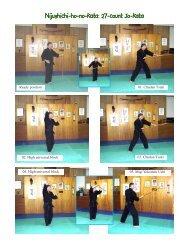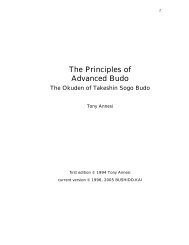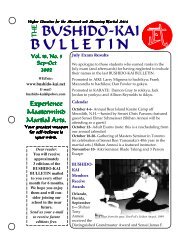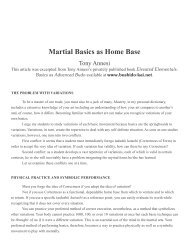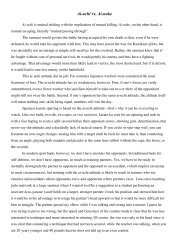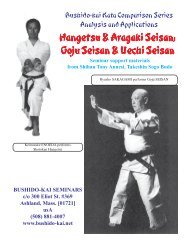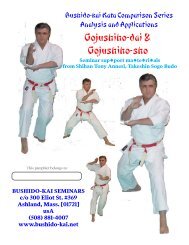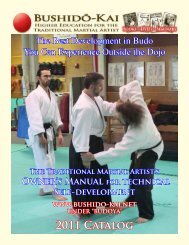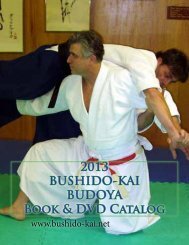Empi/Wanshu Empi/Wanshu Empi/Wanshu Empi ... - Bushido-Kai
Empi/Wanshu Empi/Wanshu Empi/Wanshu Empi ... - Bushido-Kai
Empi/Wanshu Empi/Wanshu Empi/Wanshu Empi ... - Bushido-Kai
You also want an ePaper? Increase the reach of your titles
YUMPU automatically turns print PDFs into web optimized ePapers that Google loves.
NAME:<br />
<strong>Bushido</strong>-kai <strong>Bushido</strong>-kai Kata Kata Comparison Comparison Series<br />
Series<br />
Analysis Analysis and and Applications<br />
Applications<br />
<strong>Empi</strong>/<strong>Wanshu</strong><br />
<strong>Empi</strong>/<strong>Wanshu</strong><br />
Matsukaze/Wankan<br />
Matsukaze/Wankan<br />
Seminar support materials<br />
from Shihan Tony Annesi, Takeshin Sogo Budo<br />
Teiji KAZE (France) performs Shotokan <strong>Empi</strong>.<br />
BUSHIDO-KAI SEMINARS<br />
c/o 300 Eliot St. #369<br />
Ashland, Mass. [01721]<br />
usA<br />
(508) 881-4007
E m p i / W a n s h u<br />
Additional Information compiled by Shihan Tony Annesi & Toby Reed<br />
History & Name<br />
• Potentially one of the oldest kata in karate (however, estimated dates vary between 17th Century<br />
and very early 19th century).<br />
• The common belief is that <strong>Wanshu</strong> kata developed in Tomari especially by Masters SENAEDA<br />
and MATSUMORA and, later, a Shuri-te version developed from Masters Sokon MATSUMURA<br />
and Ankoh ITOSU; but there is enough conflicting evidence to suggest that both Tomari and Shuri<br />
had a verison of the kata at the same time or that Shuri did not have it at all. Another lineage<br />
states that Chotoku KYAN learned <strong>Wanshu</strong> from MAEDA and passed it on to NAGAMINE. This<br />
also suggests a Tomari-te lineage.<br />
• The ideographs for EMPI (also pronounced as Enpi) means a “Flying Swallow” to remind us of<br />
the common features of many “bird” kata: up and down, in and out motion. Its original name was<br />
WANSHU (some pronounce it Hanshu) but the ideographs for this pronunciation are completely<br />
undecided and therefore the word has no definite meaning beyond that of a name. Ryusho<br />
SAKAGAMI in his Karate-do Kata Taikan uses the ideographs which mean “Arm Excellence” but<br />
this is probably fitting a meaning to the sound rather than being historically accurate.<br />
• Shoshin NAGAMINE uses a specific set of characters for WANSHU but those characters, which<br />
translate roughly into “Oar in the Water”, are not the characters used by the emissary WANSHU<br />
and thus are a modern inaccuracy. This is complicated by the fact that WANSHU (the name) is<br />
commonly considered the Japanese pronunciation of the Chinese WANG Ji. But WANG Ji would<br />
be transliterated into Oushu, not <strong>Wanshu</strong>. But perhaps Wan is the Okinawan pronunciation of the<br />
Japanese Ou. If this is so, who then was Wang Ji?<br />
• WANG Ji was a Supposhi (embassary) who arrived in Okinawa in 1683 (according to Ryusho<br />
SAKAGAMI) and stayed for only six months. Was this enough time to teach Okinawans and have<br />
a kata named after him?<br />
General<br />
• EMPI shows up/down as well as in/out motions while WANSHU tends to show only the in/<br />
out motions<br />
• The embusens of EMPI and each WANSHU variation are different, but one can see a similarity<br />
in the general L-shape<br />
• Isshin and some Shito schools refer to this kata as “The Dumping Form” perhaps because of the<br />
kata guruma (shoulder wheel) throw illustrated near the end of the kata.<br />
• Wankan (Matsukaze), <strong>Wanshu</strong> (<strong>Empi</strong>) and Wandoh (Wanduan) may be related kata, all from<br />
Tomari-te.<br />
Other Versions<br />
• Isshin-ryu (Kyan to Tatsuo Shimabuko); Matsubayashi-ryu (Maeda to Nagamine); Itosu-kai<br />
Shito-ryu (Mabuni? to Sakagami); Seibukan Shorin-ryu (Kyan to Zenryo Shimabuko); Okinawan<br />
Kenpo (Toma to Odo); Kyan to Okuhira Bunei; Shorei-ryu; Gohakukai Tomari-di (Seiyu to Iken: 2<br />
versions Dai and Sho)<br />
NOTE: “2 versions” may give a hint as to the variation in main versions above
References:<br />
• Alexander, George W., Okinawa, Island of Karate , Yamazato Publications,1991<br />
• KANAZAWA, Hirokazu, Shotokan Karate International Kata (Vol. 1), 1981<br />
• Kim, Richard, “KATA”, Dojo Magazine, vol. 1, no. 1, Fall 1992<br />
• NAKAYAMA, Masatoshi, Best Karate (Vol. 7), Kodansha International, 1981<br />
• Morris, Vince & Aiden Trimble, Karate Kata and Applications, Vol 2, Stanley Paul Pub., 1990<br />
• Reed, Tobey, <strong>Wanshu</strong> no Kata (a report, 9/00)<br />
• Reed, Tobey, Wansu (personal handout to students)<br />
• SAKAGAMI, Ryusho, Karate-do Kata Taikan, Japan Publications, 1978.<br />
BUSHIDO-KAI SEMINARS, c/o 300 Eliot St., Ashland, Mass. [01721] 508 881-4007<br />
The following illustrated outline of the kata comes from KARATE-DO NO SHOSAI<br />
(The Details of Karate-do) Volume 4: Nidan by Tony Annesi<br />
(Available through BUSHIDO-KAI BUDOYA, this manual includes 9 other forms, suggested bunkai,<br />
as well as Takeshin Nidan sparring and kicking requirements.)
Because the WANSHU varaitions taught at this seminar are not on the<br />
rank requirement list in Takeshin Karate-do, we have not provided illustrations<br />
for thaose forms. Refer to the seminar videotape for the sequences of those forms.
Matsukaze l Wankan<br />
(Pine Wind) (King’s Crown)<br />
Additional Information compiled by Shihan Tony Annesi<br />
• There are two distinct kata bearing the name Wankan (“King’s Crown”): the first is the Shitoryu<br />
form also known as Matsukaze (literally “Pine Wind” or figuratively “Wind through the<br />
Pines”); the second is the Shotokan form Wankan (“King’s Crown”) which, at first glance, bears<br />
no resemblance to the Matsukaze form<br />
History & Name<br />
• Matsukaze is said to descend from tomari village through Matsumora and is preserved in<br />
Shito-ryu, Matsubayashi Shorin and other styles<br />
• Shotokan’s Wankan, although seemingly different, is said to descend from Tomari-te and thus<br />
is probably a variation or a derivation of Matsukaze<br />
• SAKAGAMI uses ideographs for Wankan which translate into “Arm Piercing” or “Piercing<br />
Arm” but this is probably a fanciful name based on the sound of the word<br />
• Funakoshi changed the name of Wankan to both Shiofu (“Tide” or “Appearance”) and Hito<br />
(“Man”, “Mankind”, or “Messenger”) but the old name prevailed<br />
• Although Pine Wind and Tide suggest the back and forth wave of the signature movement in<br />
Matsukaze, I have been unable to discern why the term “King’s Crown” is relevant to either<br />
kata<br />
General<br />
• Wankan (Matsukaze), <strong>Wanshu</strong> (<strong>Empi</strong>) and Wandoh (Wanduan) may be related kata, all from<br />
Tomari-te<br />
• Both Matsukaze and Wankan are based on the L- or modified T-shape but the direction of the<br />
L or T differs from one kata to the other<br />
• Shito’s Matsukaze is considered a basic or intermediate kata while Shotokan’s Wankan is<br />
usually listed as an advanced kata despite the fact that it is the shortest form in the Shotokan<br />
syllabus<br />
References:<br />
• Alexander, George W., Okinawa, Island of Karate , Yamazato Publications, 1991<br />
• KANAZAWA, Hirokazu, Shotokan Karate International Kata (Vol. 2), 1981<br />
• Kim, Richard, “KATA”, Dojo Magazine, vol. 1, no. 1, Fall 1992<br />
• NAGAMINE, Shoshin, The Essence of Okinawan Karate-do, Tuttle, 1976<br />
• NAKAYAMA, Masatoshi, Best Karate (Vol. 7), Kodansha International, 1981<br />
• Morris, Vince & Aiden Trimble, Karate Kata and Applications, Vol. 4, Stanley Paul Pub., 1990<br />
• SAKAGAMI, Ryusho, Karate-do Kata Taikan, Japan Publications, 1978.<br />
BUSHIDO-KAI SEMINARS, c/o 300 Eliot St., Ashland, Mass. [01721] 508 881-4007<br />
The following illustrated outline of the kata comes from KARATE-DO NO SHOSAI<br />
(The Details of Karate-do) Volume 4: Nidan by Tony Annesi<br />
(Available through BUSHIDO-KAI BUDOYA, this manual includes 9 other forms, suggested<br />
bunkai, as well as Takeshin Nidan sparring and kicking requirements.)
BUSHIDO-KAI SEMINARS,<br />
c/o 300 Eliot St., Ashland, Mass. [01721]<br />
508 881-4007<br />
The preceding illustrated outline<br />
of the kata comes from<br />
KARATE-DO NO SHOSAI<br />
(The Details of Karate-do)<br />
Volume 4: Nidan by Tony Annesi<br />
(Available through<br />
BUSHIDO-KAI BUDOYA,<br />
this manual includes 9 other<br />
forms, suggested bunkai, as well as<br />
Takeshin Nidan sparring and<br />
kicking requirements.)<br />
NOTE: The presentation of this<br />
seminar on videocassette,<br />
professionally edited in vinyl<br />
library case is available from<br />
BUSHIDO-KAI BUDOYA at the<br />
above phone number.<br />
Ryusho SAKAGAMI performs Itosu-kai <strong>Wanshu</strong>.



